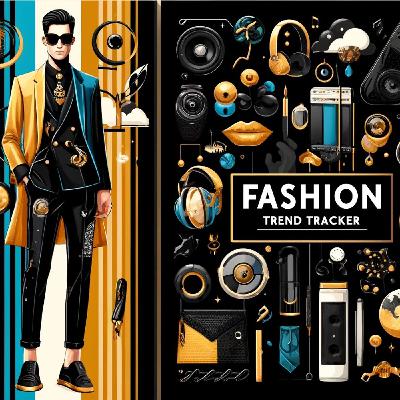Fashion Industry in Flux: Collaborations, Sustainability, and the Rise of Global Creativity
Update: 2025-11-06
Description
Over the past 48 hours, the global fashion industry has seen dynamic activity marked by bold collaborations, new product launches, shifting consumer sentiment, and market disruption. Luxury fashion houses and mass-market players alike are leveraging strategic partnerships to invigorate their brands. Louis Vuitton revived its iconic collaboration with Takashi Murakami, unveiling a re-edition collection featuring anime-inspired artistry to entice both nostalgic and younger audiences. Balenciaga and Under Armour launched a performance-wear line integrating technical fabrics, aiming to capture Asia’s surging luxury sportswear market.
The spotlight is on accessibility as J.Crew and Araks debuted an everyday-luxury capsule with all items under $200, countering rising prices with approachable designerwear. H and M’s collaboration with Glenn Martens was announced, signaling further moves to democratize high fashion through edgy streetwear delivered to a global audience in time for Autumn 2025.
Fast-fashion giant Shein caused a stir by opening its first physical store in Paris this week, attracting throngs of shoppers and vocal protesters raising concerns over environmental and labor practices. Their foray into brick-and-mortar signals a trend where digital-only retailers seek legitimacy and broader reach in established markets.
South Korea’s fashion industry is drawing global attention. K-fashion’s gender-fluid tailoring and acubi minimalism are influencing mainstream styles, supported by surging exports and international runway participation. This pivot towards inclusivity and creativity is challenging Western dominance and giving rise to new competitors.
In sports-fashion crossovers, Mike Amiri’s recent deal with football powerhouse FC Barcelona underscores the powerful fusion of sports and luxury branding, edgy sneakers and streetwear now being symbols of status and athleticism.
Notably, consumer surveys reveal that 85 percent of younger shoppers link their fashion choices to travel experiences, up from 74 percent reported last year. That marks a shift toward globally inspired, eclectic apparel. Supply chain volatility persists, but leaders like Moncler counter challenges with limited-edition tech-enabled products such as solar-powered sleep capsules and carbon-frame tents retailing above $100,000. Meanwhile, brands are adopting QR-coded care tags for better transparency in ethical sourcing.
Compared to previous quarters, the industry is shifting from insular luxury toward brand openness, inclusivity, and experiential products. Price increases continue but are offset by more collaborative lines aimed at accessibility and ethical transparency. Regulatory protests and activist scrutiny are rising, especially around sustainability and labor. Industry leaders are responding by prioritizing transparency, global creativity, and tech-driven limited-edition products, setting a new agenda for fashion heading into 2026.
For great deals today, check out https://amzn.to/44ci4hQ
This content was created in partnership and with the help of Artificial Intelligence AI
The spotlight is on accessibility as J.Crew and Araks debuted an everyday-luxury capsule with all items under $200, countering rising prices with approachable designerwear. H and M’s collaboration with Glenn Martens was announced, signaling further moves to democratize high fashion through edgy streetwear delivered to a global audience in time for Autumn 2025.
Fast-fashion giant Shein caused a stir by opening its first physical store in Paris this week, attracting throngs of shoppers and vocal protesters raising concerns over environmental and labor practices. Their foray into brick-and-mortar signals a trend where digital-only retailers seek legitimacy and broader reach in established markets.
South Korea’s fashion industry is drawing global attention. K-fashion’s gender-fluid tailoring and acubi minimalism are influencing mainstream styles, supported by surging exports and international runway participation. This pivot towards inclusivity and creativity is challenging Western dominance and giving rise to new competitors.
In sports-fashion crossovers, Mike Amiri’s recent deal with football powerhouse FC Barcelona underscores the powerful fusion of sports and luxury branding, edgy sneakers and streetwear now being symbols of status and athleticism.
Notably, consumer surveys reveal that 85 percent of younger shoppers link their fashion choices to travel experiences, up from 74 percent reported last year. That marks a shift toward globally inspired, eclectic apparel. Supply chain volatility persists, but leaders like Moncler counter challenges with limited-edition tech-enabled products such as solar-powered sleep capsules and carbon-frame tents retailing above $100,000. Meanwhile, brands are adopting QR-coded care tags for better transparency in ethical sourcing.
Compared to previous quarters, the industry is shifting from insular luxury toward brand openness, inclusivity, and experiential products. Price increases continue but are offset by more collaborative lines aimed at accessibility and ethical transparency. Regulatory protests and activist scrutiny are rising, especially around sustainability and labor. Industry leaders are responding by prioritizing transparency, global creativity, and tech-driven limited-edition products, setting a new agenda for fashion heading into 2026.
For great deals today, check out https://amzn.to/44ci4hQ
This content was created in partnership and with the help of Artificial Intelligence AI
Comments
In Channel





